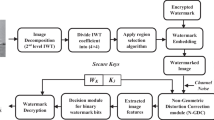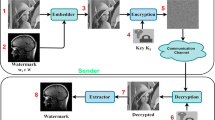Abstract
This paper proposes an improved tampering detection algorithm for image authentication, using distributed source coding (DSC) principle, by partitioning the image into N equal clusters, for Slepian-Wolf coding. The proposed DSC based technique for authentication, models the magnitude variation in pixel domain generated by acceptable distortion and illegal tampering as Normal distributions with small and large variances respectively. DSC coding is done for the feature vectors derived from the partitioned image. The feature extraction algorithm is revamped in the aim to produce feature vectors with statistical features well matched to low density parity check (LDPC) codes, designed for the binary symmetric channel (BSC), as the design of LDPC codes for the BSC is intensely investigated and also a well understood topic. The results reveal that, the proposed scheme’s tampering detection is superior than the earlier DSC based techniques.















Similar content being viewed by others
References
Bhattacharjee, S., & Kutter, M. (1998). Compression tolerant image authentication. IEEE International Conference on Image Processing, Chicago, 1, 4–7.
Cox, I. J., Kilian, J., Leighton, T., & Shamoon, T. (1996). Secure spread spectrum watermarking for images, audio and video. Proceedings of IEEE International Conference on Image Processing, Lausanne, 3, 243–246.
Eggers, J. J., & Girod, B. (2001). Blind watermarking applied to image authentication. Proceedings of IEEE International Conference on Acoustics, Speech, and Signal Processing, Salt lake City, UT, 3, 1977–1980.
Wolfgang, R. B., & Delp, E. J. (1996). A watermark for digital images. Proceedings of IEEE International Conference on Image Processing ICASSP, Lausanne, 3, 219–222.
Barni, M., Bartolini, F., Manetti, A., & Piva, A. (2001). A data hiding approach for correcting errors in h.263 video transmitted over a noisy channel. In Proceedings of MMSP01, IEEE workshop on multimedia signal processing, Cannes, pp. 65–70.
Goldwasser, S., & Micali, S. (1984). Probabilistic encryption. Journal of Computer and System Sciences, 28(2), 270–299.
Fridrich, J. (2000). Visual hash for oblivious watermarking. In Proceedings of SPIE, security and watermarking of multimedia contents II, San Jose, California, USA, pp. 286–294.
Mihcak, M. K., & Venkatesan, R. (2001).Video watermarking using image hashing. Microsoft Research Technical Report.
Ozer, H., Sankur, B., Memon, N., & Anarim, E. (2005). Perceptual audio hashing functions. EURASIP Journal on Applied Signal Processing, 12, 1780–1793.
Swaminathan, A., Mao, Y., & Wu, M. (2006). Robust and secure image hashing. IEEE Transactions on Information Forensics and Security, 1(2), 215–230.
Mihcak, K., Venkatesan, R., & Liu, T. (2005). Watermarking via optimization algorithms for quantizing randomized semi-global image statistics. ACM Multimedia Systems Journal, 11(2), 185–200.
Monga, V., & Evans, B. L. (2006). Perceptual image hashing via feature points performance evaluation and trade-offs. IEEE Transactions on Image Processing, 15(11), 3452–3465.
Schneider, M., & Chang, S. (1996). Robust content based digital signature for image authentication. In Proceedings of IEEE international. Conference on image processing, (3), Lausanne, pp. 227–230.
Kailasanathan, C., & Safavi Naini, R. (2001). Image authentication surviving acceptable modifications using statistical measures and k-mean segmentation. In Proceedings of IEEE-EURASIP Work. Nonlinear sig. and image processing.
Venkatesan, R., Koon, S.-M., Jakubowski, M. H., & Moulin, P. (2000). Robust image hashing. Proceedings of IEEE International Conference on. Image Processing, 3, 664–666.
Lin, C. Y., & Chang, S. F. (2001). A robust image authentication system distinguishing JPEG compression from malicious manipulation. IEEE Transactions on Circuits and Systems for Video Technology, 11(2), 153–168.
Lin, C. Y., & Chang, S. F. (1998). A robust image authentication method surviving JPEG lossy compression. In SPIE conference on storage and retrieval for image and video database, San Jose, CA.
Lee, J., & Won, C. S. (2000). A watermarking sequence using parities of error control coding for image authentication and correction. IEEE Transactions on Consumer Electronics, 46(2), 313–317.
Noriega, J. A. M., Kurkoski, B. M., Miyatake, M. N., & Meana, H. P. (2011). Image authentication and recovery using BCH Error-correcting codes. International Journal of Computers, 5(1), 26–33.
Lin, Y. C., Varodayan, D., & Girod, B. (2007). Image authentication based on distributed source coding, In IEEE international conference on image processing, San Antonio, TX, ICIP 2007, Vol.3, III-5-III8.
Varodayan, D., Aaron, A., & Girod, B. (2006). Rate-adaptive codes for distributed source coding. EURASIP Signal Processing Journal, Special Section on Distributed Source Coding, 86(11), 3123–3130.
Lin, Y.-C., Varodayan, D., & Girod, B. (2007). Spatial models for localization of image tampering using distributed source codes. Picture Coding Symposium.
Lin, Y.-C., Varodayan, D., & Girod, B. (2007). Image authentication and tampering localization using distributed source coding. IEEE Multimedia Signal Processing Workshop.
Varodayan, D., Chen, David, Flierl, Markus, & Girod, Bernd. (2008). Wyner-Ziv coding of video with unsupervised motion vector learning. Signal Processing: Image Communication, 23(5), 369–378.
Lin, Y. C., Varodayan, D., & Girod, B. (2012). Image authentication using distributed source coding. IEEE Transactions on Image Processing, 21(1), 273–283.
Slepian, D., & Wolf, J. K. (1973). Noiseless coding of correlated information sources. IEEE Transactions on Information Theory, 19(4), 471–480.
Liveris, A., Xiong, Z., & Georghiades, C. (2002). Compression of binary sources with side information at the decoder using LDPC codes. IEEE Communications Letters, 6(10), 440–442.
Chen, J., He, D., & Jagmohan, A. (2006). Slepian-Wolf code design via source-channel correspondence (pp. 2433–2437). Seattle, WA: Proceedings of IEEE International Symposium on Information Theory.
Author information
Authors and Affiliations
Corresponding author
Rights and permissions
About this article
Cite this article
Masoodhu Banu, N.M., Sujatha, S. Improved Tampering Detection for Image Authentication Based on Image Partitioning. Wireless Pers Commun 84, 69–85 (2015). https://doi.org/10.1007/s11277-015-2594-9
Published:
Issue Date:
DOI: https://doi.org/10.1007/s11277-015-2594-9




